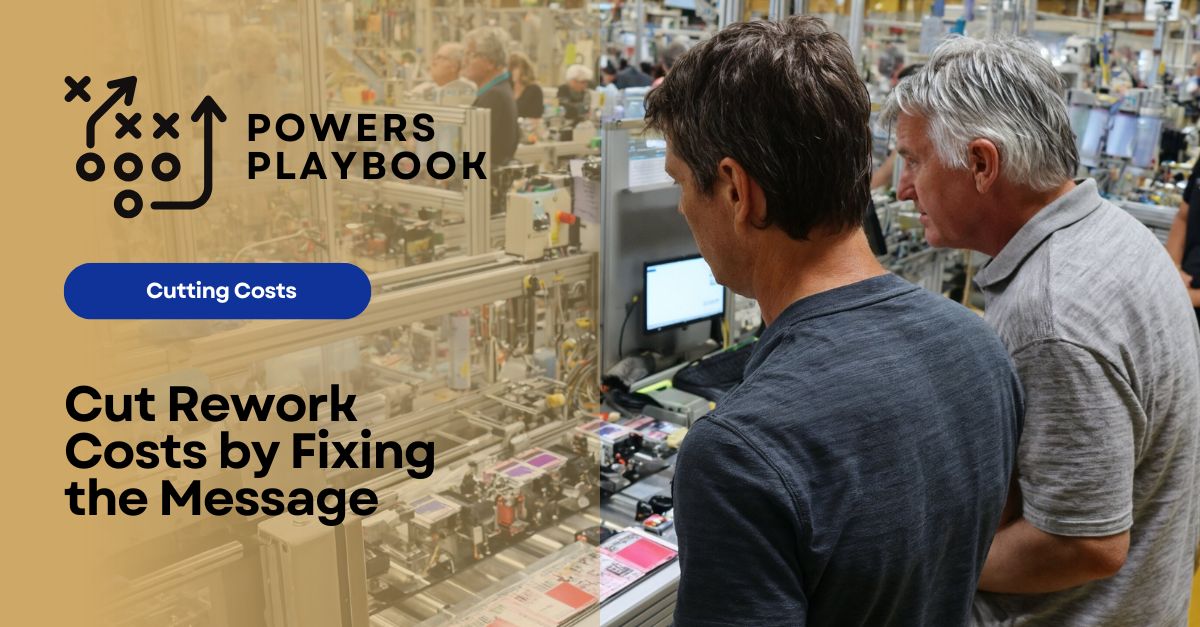
Rework is expensive, and it’s usually preventable. Every time a job has to be done over, it costs twice as much in time, labor, and materials. Most people assume rework is a quality issue or a training gap.
But the truth is, poor communication is often the root cause.
This post wraps up our July playbook series on cutting costs without cutting corners. We’ve covered the impact of excessive overtime, unexpected maintenance, and inefficient layout. Now we’re focusing on something that connects them all: communication.
Here’s how supervisors and teams can reduce rework by making small but powerful changes to how information is shared, tracked, and acted on.
1Miscommunication Is the Root of Most Rework
Most rework doesn’t come from bad work. It comes from unclear work.
A job gets done wrong because the instructions were vague. Someone skips a step because they weren’t told about a process change. An operator uses the wrong version of a spec sheet taped to the wall from six months ago.
And often, these errors aren’t discovered until the next step in the process, or worse, when the product is headed out the door.
Quick Win
Pick a handful of the most frequent rework issues happening on your floor. Sit down with your team leads and ask one question: “Where did the information break down?” You’ll start to see patterns that point to weak spots in your communication process, not in your people.
2Add a Check, Not a Chase
When something gets built or packaged wrong, teams scramble to figure out what happened and who did it. That’s time wasted chasing a problem that could’ve been caught earlier with a simple pause point.
You don’t need a complex system to prevent rework, you just need intentional checks built into the flow.
Quick Win
Create a low-friction feedback loop using tools your team already knows how to use: red tags, simple check sheets, or a dedicated space on a whiteboard for first-pass yield notes. Let operators flag issues before they become rework. Don’t wait for an audit or end-of-line rejection to surface a fixable issue.
Even a small visual reminder in high-risk areas (like a sticker that says, “STOP: Did you confirm the fixture setting?”) can help reduce rework at the source.
3Handoffs Aren’t a Time to Chat
The end of a shift is not the time to “wing it.” Poor handoffs are one of the most consistent sources of avoidable errors, especially in 24/7 operations.
When the outgoing team doesn’t clearly share what happened, what’s still in progress, and what problems are unresolved, the incoming shift either repeats the same errors or wastes time figuring things out on their own.
Quick Win
Introduce a 3-point shift handoff checklist:
- What went wrong during the last shift
- What was fixed or adjusted
- What still needs attention
Make sure it’s written somewhere visible, on a whiteboard, a handoff sheet, or inside your digital production system (if you’re using one). Build 5 minutes of structure into every shift change to prevent 50 minutes of confusion later.
🔗 This connects directly to Cutting Overtime Without Sacrificing Output. When shifts communicate well, the next team doesn’t have to stay late fixing what the last one left behind.
4Standardize the Message
One of the biggest causes of rework is variation, not in the product, but in how people interpret instructions. Even with a great SOP in place, if one person learned by watching someone else, and another learned from a printed doc, they may be doing things two very different ways.
Standard work only works if the standard is clear, consistent, and reinforced.
Quick Win
Update SOPs with step-by-step photos, simple markup, and real-world examples, not just “corporate-speak.” Then do a walk-through on the floor with the team. This reinforces the standard visually, physically, and verbally all at once.
If you’re using temporary labor or new hires, visual instructions are especially critical. A laminated one-pager at the station can prevent dozens of small errors throughout the day.
5Close the Loop With Maintenance
Some rework stems from equipment that’s not quite right: a tool that slips, a sensor that misreads, a clamp that won’t lock in place. If those issues don’t get flagged clearly and addressed quickly, they repeat shift after shift, each time costing the company more in wasted labor and materials.
Quick Win
Start a simple log that links rework incidents to potential equipment issues. If an operator rejects a part or catches a defect, ask: Could this be mechanical? If so, tag it and make sure maintenance sees it, not just the supervisor.
Better yet, build a routine where maintenance and production leads review the rework log together once a week. This helps you spot chronic issues before they become hidden costs.
🔗 See Planning Maintenance to Avoid Costly Breakdowns to understand how proactive maintenance pays off not just in uptime, but in fewer process mistakes.
6Make Layouts Speak for Themselves
When operators have to guess where materials go, fight through crowded spaces, or dig through bins for the right part, mistakes happen. And even when they don’t, those extra steps cost time, which costs money.
A well-designed workspace reduces the need for instructions. It tells the story visually.
Quick Win
Use colored floor tape, tool shadow boards, labeled bins, and “ready vs. not ready” zones. Even simple signage like “Step 1, Step 2” posted above a workstation can keep the process moving in the right direction.
Combine this with standardized work visuals, and your floor becomes more self-explanatory, especially for floaters, new hires, or temps.
🔗 This supports the improvements from Improving Layout to Reduce Movement Waste. When layout and communication work together, everything flows smoother, and mistakes go down.
How POWERS Can Help
At POWERS, we understand that rework, downtime, and waste don’t just come from technical failures, they often come from unclear expectations, inconsistent follow-through, or gaps in day-to-day communication. That’s why our team works side-by-side with manufacturing leaders to identify and fix the real behavioral and process breakdowns that quietly drain productivity.
To support these frontline improvements, we also developed DPS, a practical digital production system built to work the way your team works. DPS gives supervisors and leads the structure they need to:
- Track performance across shifts in real time
- Log and flag rework incidents as they happen
- Spot trends that point to recurring breakdowns or coaching opportunities
- Act on issues before they spiral into excessive costs or production delays
Whether your biggest challenges are inconsistent handoffs, repeat quality issues, or unnecessary rework, our goal is the same: make your processes easier to follow, your leaders more effective, and your operation more cost-efficient, without adding complexity or overhead.
If you’re ready to stop paying for the same mistakes twice, and want to equip your supervisors with the tools and coaching they need to get it right the first time, we’re here to help.
- Speak to an Expert: Call +1 678-971-4711 to discuss your specific challenges and goals.
- Email Us: Get tailored insights by emailing info@thepowerscompany.com
- Request an Assessment: Use our online contact form, and one of our expert manufacturing consultants will reach out to schedule an in-depth analysis of your operations.


